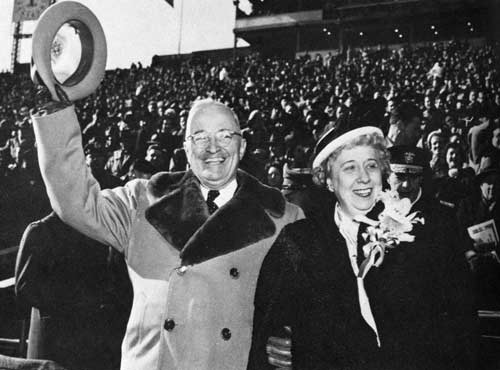
Background
Bess Truman was born Elizabeth Virginia Wallace on February 13, 1885 in Independence, Missouri. She was born to the prestigious Wallace family and grew up in luxury in a Victorian house on Delaware Street. She is best known for being the 33rd First Lady of the United States when her husband, Harry S. Truman, became President in 1945. Bess and Harry’s relationship began long before they were married, giving this couple a very rich history.
Harry Truman was born in Lamar, Missouri in 1884 to a farm family. His family moved often, and they came to Independence in 1890. There, Harry met and immediately became smitten with a young Elizabeth Wallace. The two children met in Sunday School at the First Presbyterian Church on the Independence Square. Harry was six and Bess was five. While Harry frequently said that he fell in love with Bess as soon as he met her, she was not as taken with Harry. He worked hard to court Bess for the better part of thirty years.
Harry and Bess became engaged in 1917. Their marriage was put on hold until Truman returned from Europe during World War I, but after his return to the United States they were married on June 28, 1919. They welcomed their one and only daughter, Margaret Truman, on February 17, 1924. Bess’ life changed drastically when her husband became President following the sudden death of Franklin Delano Roosevelt on April 12, 1945. Bess was not interested in living a glamorous life in the public eye, but wanted to keep living the quiet lifestyle that she was used to.
One of the distinctive elements of their relationship was the camaraderie between Bess and Harry. Historians have evidence of this close relationship from a series of letters often referred to as the “Dear Bess” Letters. Harry Truman frequently sought his wife’s advice and opinions on his political actions. Bess was also Harry's main speech writer. Due to her strong influence in his life, Harry gave Bess the nickname “The Boss.” Bess was very headstrong and was determined to handle being First Lady in her own way. She made her own decisions and ignored some of the traditional roles of the position. She preferred to keep away from the public eye and refused to hold press conferences like the previous First Lady, Eleanor Roosevelt, had done.
In Harry Truman’s “Dear Bess” Letters, he conversed with his wife about his political decisions to a great extent. In fact, Bess became such an integral part of Harry’s decision-making process that she grew furious when Harry did not consult her before dropping the atomic bomb on Japan. Their daughter Margaret later wrote that Bess “had become a spectator rather than a partner in Harry Truman’s presidency. That made her very angry.”
Key Question
What is Truman’s tone when he writes to Bess about major world events compared to the tone used in classified and unclassified documents?
Materials
Documents to be examined:
- Letter from Harry to Bess Truman, July 31, 1945
- Henry Stimson to Harry Truman, July 31, 1945
- Letter from Harry to Bess Truman, July 23, 1948
- Letter from Harry to Bess Truman, August 6, 1948
- Memorandum, Summary of Telegrams from the Department of State, June 29, 1948
- Letter from Harry to Bess Truman, July 12, 1950
- Army Department Message, July 10, 1950
- Letter from Harry to Bess Truman, September 30, 1947
- “The Immediate Need for Emergency Aid to Europe,” September 29, 1947
- Letter from Harry to Bess Truman, July 20, 1945
- Letter from Harry to Bess Truman, July 25, 1945